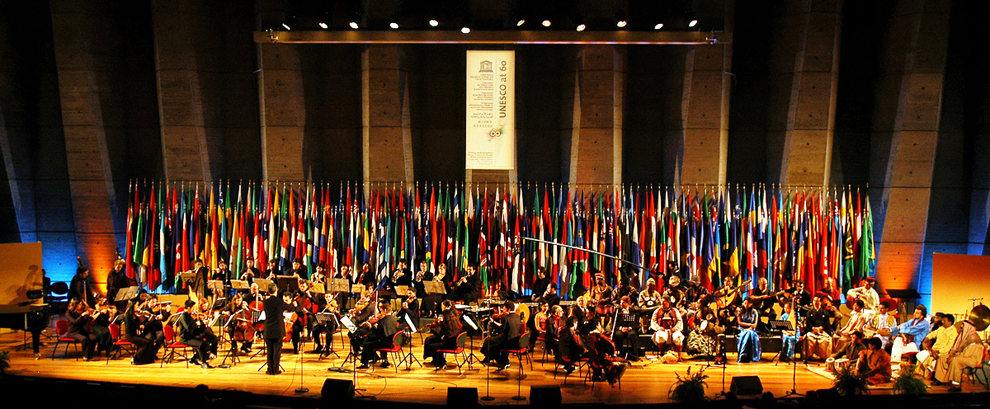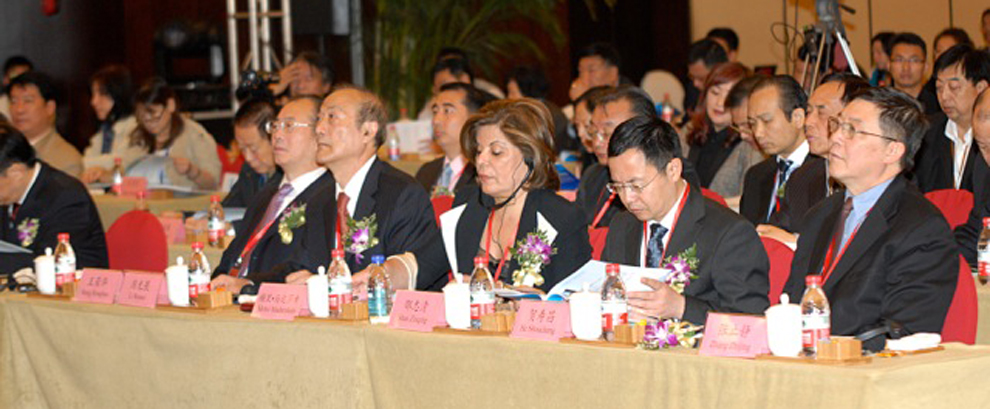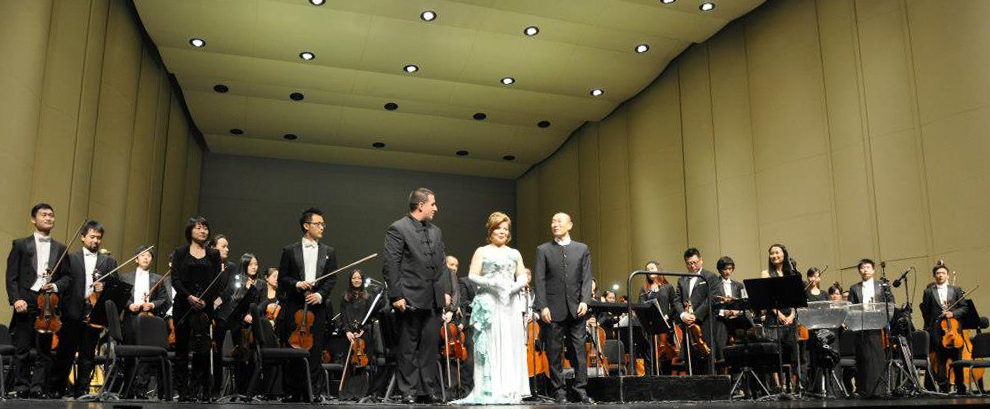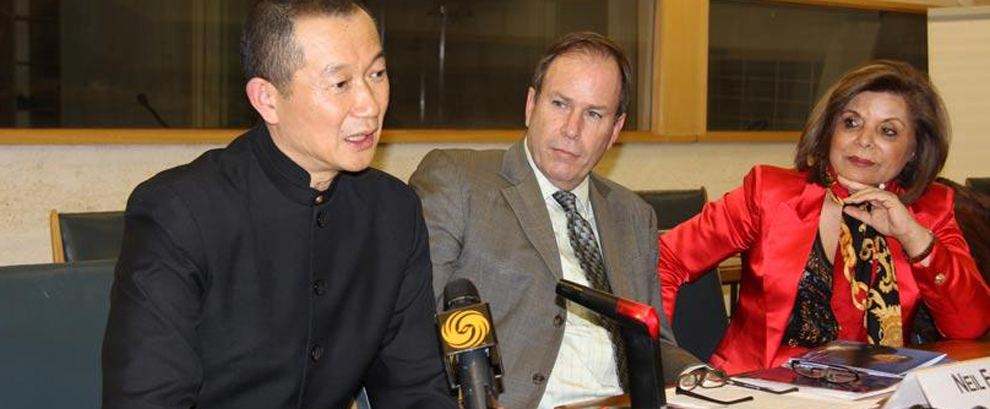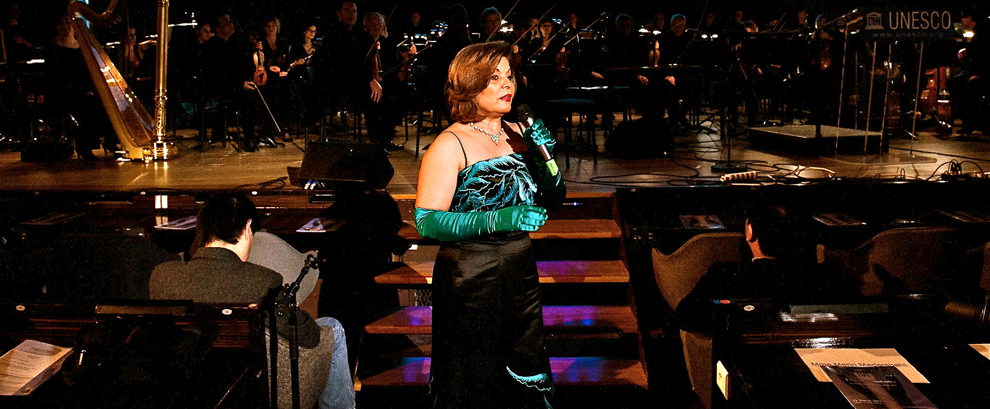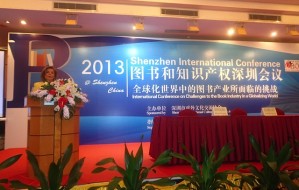
International Conference on “Book Industries Facing the Challenges of the Future”
1-2 March 2013
Shenzhen, China
Mehri Madarshahi
Are conventional book industries facing a revolution?
The Value of the Book
A Common and Shared Heritage of Humanity
The dynamics affecting books are at the centre of our concerns because the written word, the book, is an essential condition for the dissemination of the creations of human’s mind. This process is central to the development of cultures and civilizations. Books in their various forms have appeared on all continents, with two important sources of diffusion in the Euro-Arab world and China, where the tradition of writing and printing books has been continuously maintained for more than 25 centuries.
However, the modern landscape has an important impact on the evolution of books, as we start wondering if John Updike was right when he claimed in a poem: “The printed page/ was just half a millennium’s brief wonder.”
Today, as we will discuss the digital book and its impact on the conventional book, we must remember that books have been developed throughout history in a close connection with the materials they were written on, expressing a large diversity of cultures. Silk was used in China, as well as bamboo, which happens to be represented in the Chinese character for “book”. In other times and places, human cultures have used bone, bronze, pottery, shell, parchment, or wood, as was found in some Polynesian Islands. Mesopotamia created books in the form of clay tablets some 5 000 years ago, while Egyptians used papyrus books to narrate their mythologies or the reign of their kings on scrolls that could be more than 30 meters long. China also knows significant scroll books.
What we consider the conventional form of books was born in China, where paper, one of treasures of a scholar, besides the brush, ink and inkstone, was invented around the 1st century, and where the first printing of books appeared under the Tang Dynasty, probably around the 9th century. Under European influence, such the mechanization of paper manufacture by medieval papermakers and by Gutenberg’s press, the print became the equivalent of the book in a form that has stayed with us until now, thanks to a long history of intercultural exchanges.
No matter the context or the time-frame, the book definitely qualifies as a denominator of shared heritage of humanity in double sense: cultures inherit books from their past and transmit their books to other cultures. Books embody one of the most powerful forms of dialogue between individuals, within communities, between generations and with other societies by improving our knowledge of others and of their philosophies, and enhancing our understanding of the world. They thus provide human development opportunities, for all ages and, in particular, for young people. They also have the inbred power of generating conflicts, such as in the case of contested curriculum reform or they can be taken as objects of (religiously inspired) hate, as we have seen recently in Mali.
Books can transform our individual mindsets and collective views and perceptions because they are a dynamic force for change There is a hunger for reading among youth in many countries that goes unsatisfied, partly due to a lack of book production, libraries or access to the internet.
The Creative Industry of the Book
Indeed, from scrolls to codices, from manuscripts to printed matter and tablet computers, books have changed in appearance over the centuries, but they remained, in all formats and forms, a central dimension of our cultural practices and, therefore of our economic development, which cannot be sustainable and endogenous if it does not express our cultural identity.
This is an essential dimension in the 2005 UNESCO Convention on the Protection and Promotion of the Diversity of Cultural Expressions, which encourages governments, the private sector and civil society to better recognize the positive role of culture of development. As one of the most significant of those cultural expressions, the book is clearly an important dimension of the creative market. The United Nations Conference for Trade and Development (UNCTAD) reported in its last report on Creative industries that book exports increased from $11 billion in 2002 to $19 billion in 2008. This growth is significant and has been consistent in the most recent years.
As is the case in many other sectors of the creative industries, developed economies dominated the world market for publishing and printed media exports with 80 per cent of world exports. Nevertheless, the dynamics of the planet are evolving and developing countries, despite their slight participation in world markets, increased their exports from $3.2 billion to $8.1 billion. China plays a significant role in this development, which is paralleled in the other creative industries. As noted also by UNCTAD, Chinese exports of publishing material and printed media sharply increased from $535 million to $2.4 billion, even if trade data cannot distinguish creative products “made” in China from those “created” in China. Positive developments also took place in most developing and emerging countries.
These figures are crucial because they testify to deep transformations of our societies, transformations that we must associate with the book. Knowledge has become an increasingly important vector for modern economies, especially in the context of globalization and could be labelled as a production factor sui generis.
A knowledge-based economy thrives on technologies and related innovation, especially of ICTs, and it is associated with a palpable expansion of the services sector. The concept of a knowledge-based economy holds that innovation, intellectual property, highly specialised skills and the capacity to cope with change are increasingly significant drivers of every economic sector. This underlines the need for increased investments in education at all levels which in turn, calls for increased attention to the development of the book, which remains a strategic vector for the success of education.
Most developing countries are not fully endowed to compete in the global knowledge economy. They suffer from what can be termed a knowledge divide, which translate itself into a book divide. More profoundly, according to UNESCO’s latest statistics, most of the 200 million people aged 15 to 24 who have not even completed primary school (most of them girls and women) worldwide are to be found in developing countries as are most of the 250 million children of primary school age who cannot read or write, whether they’re in school or not. This makes the case for investments of a critical mass in education, principally in order to achieve the six Education For All (EFA) goals and the two education-related Millennium Development Goals (MDGs).
UNESCO’s special responsibility towards books has translated into numerous programmes and activities such as Memory of the World and including the establishment in 2011 of the Regional Centre for the Promotion of Books in Latin America and the Caribbean (CERLALC). It is through this kind of structures that we oversee the coordination processes between representatives of governmental organizations, the private sector and civil society involved in creative processes, promotion of reading, libraries, and the production of and trade in books.
Celebrating the Book
It is UNESCO’s mission to ensure access to education for all people, an objective inseparable from the interests of the book industry. This effort begins in schools, through a determined fight against illiteracy among children and adults, especially in rural areas, and continues through the strengthening of cultural policies at national, regional and global levels. Without quality education, the pages of a book are silent. Books open a unique path to human and economic development that must be recognized and celebrated. It is for these reasons that 23 April has been designated in 1996 by UNESCO as World Book and Copyright Day. By commemorating this Day all through the world, UNESCO aims to promote reading, publishing and the protection of intellectual property by the means of copyright.
World Book and Copyright Day is an event meant to pay a universal mark of respect to books and authors and to remind people of the enjoyment of reading. It is also hoped that observance of the Day will put forward and raise new preoccupation concerning copyright rules intellectual copyright. Incidentally, copyright and the right to education are not divergent rights. The emergence of open educational resources (OER) can help to overcome any tension in this regard.
Policy decision-makers, publishers, librarians, educators and civil society as a whole need to bear in mind that the book is the most effective way of promoting knowledge, culture and development.
As World Book and Copyright Day proved to be such a stimulating experience, UNESCO initiated in 2001 the concept of World Book Capital City in close association with the International Publishers Associations (IPA-UIE), the International Federation of Library Associations and Institutions (IFLA) and the International Booksellers Federation (IBF). Each year, a city is selected for this title on the basis of the activities it intends to dedicate to books and reading and promote the principles of freedom of expression, freedom to publish and to distribute information, as stated in the UNESCO Constitution as well as upheld by Articles 19 and 27 of the Universal Declaration of Human Rights and by the Agreement on the Importation of Educational, Scientific and Cultural Materials (Florence Agreement). Madrid was the first city to be designated as World Book Capital City; Bangkok holds the title for 2013 and Port Harcourt, Nigeria, has been designated for 2014.
The successful establishment of such a programme demonstrates that, books remain irreplaceable. However, change is happening as we are in the middle of a so-called “digital transition”. Leading innovators such as Google, Apple and Microsoft have paved the way to edifying what is now called the “cloud culture” – a world where information and knowledge are stored in a digital cloud above us and are accessible from everywhere through the Internet. In this context UNESCO’s responsibility is to explore all of the repercussions of change, to understand it and make the most of it — while preserving those values and forms of expression that we share and cherish. Our role is to provide a platform for debate and to act as a knowledge-broker to explore old and new ideas. And clearly, the conventional book industries face a soul-searching moment regarding future paths of development.
The Revolution is the Public
A New Landscape
The question on everybody’s lips is: “Are conventional book industries facing a revolution?” The answer is “yes”. We all witness the daily transformations incurred by computers, mobile phones and tablets. But can the omnipresence of knowledge in digital form ensure universality? If knowledge is being transformed into digital forms, can we imagine a world without books and libraries? As these evolutions are gaining momentum today in the sector of the book, there are clear parallels with what had happened to the industries of photography, music or cinema. They all have been deeply transformed by the ICTs and their most visible impact: the drastic diminution in the cost of reproducing and disseminating a digitized cultural or intellectual content.
In the beginning, publishers as well as readers did not believe that books as we knew them could be somewhat displaced by electronic versions since the screen did not offer a satisfactory platform for the experience of reading. But today the electronic book has become an expanding market. Last year, the Association of American Publishers revealed that adult eBook sales were up to $282.3 million compared to $229.6 million for hardcover sales in a context where paperback sales are dropping. What is obvious is that the population of e-book readers is growing. In the past year, the number of those who read e-books increased from 16% of all Americans ages 16 and older to 23%. At the same time, the number of those who read printed books in the previous 12 months fell from 72% of the population ages 16 and older to 67%. An analyst in the industry pointed out that if the e-books keep their upward trend, they will reach half of all books sold sometime between the end of 2013 and the first half of 2014. These figures pertain to the US market, but one can see that they tell something of the future as the ICTs are ever more ubiquitous in all societies.
This growth has been made possible by the design advances of electronic readers and tablets such as Kindle or iPad, which have made reading on the screen a much more palatable experience. In parallel, more and more titles are available in a growing number of catalogues in many languages. The global book market is thus deeply affected by the rise of e-books and downloadable content, is transforming the industry and is impacting on publishers. It is touching on authors and readers. It transforms libraries (The share of recent library users who have borrowed an e-book from a library has increased from 3% last year to 5% this year.) The implications of this transformation will be deep and long-term. These changes are giving rise also to sharp new debates concerning the strengths and weaknesses of different kinds of products, the evolving nature of copyright and systems of copyright protection, the role of libraries relative to on-line knowledge, the meaning of ‘authorship’ in a world of blogs, self-publishing software, online and open source encyclopaedias such as Wikipedia and Google books, and the pitfalls of building cultural capital and name-recognition in a digitalized world.
One of the major questions is, of course, whether the conventional book will be displaced and marginalized by the digital book. If the medium is digital, what is the message? There will be a revolution, a digital transition. This is granted. But will we have conventional books to narrate it? Will we be looking back at our printed past? This questions the idea of the revolution we are discussing. Does this revolution mean destruction, in the political sense? Then the future of the book is that of film or photography which have been transformed so completely and rapidly that such centennial giants as Kodak disappeared from the global radar in what felt like an instant.
But, for such an event to happen, one has to presume that digitization is an end in itself. But the book is not only a physical object, such as a CD or MPGS but also intellectual content, which is where the focus of the industry should be. Books are at the same time an object and an idea, the written word and the object it designates, tangible in form, intangible in content.
Copyright and Human Rights
“Who owns the words? Who owns the music and the rest of our culture? We do –all of us – though not all of us know it yet. Reality cannot be copyrighted” These remarks are to be found in David Schields’ pasted-together book, in itself a demonstration of the inconsistent dimension of authorship and authenticity in a world dominated by copies.
Thus, it matters to reason in terms of intangible content because this is where the main debate has moved today, specifically with the issue of copyrights, a connection UNESCO made obvious when it decided to celebrate the book in association with the copyright. Copyright is a relatively recent concept but is fundamental because it grants recognition to the creativity of the mind, a recognition that had not been economically acknowledged as such that far. Thus it is important to recall that the copyright relates directly to human rights. In essence, the right of authors over their creation is universal and its proclamation is a hard-won conquest. The concrete manifestation of that right must be adapted to the evolutions of the present.
This self-evident truth must be understood both ways, though. On the one hand, the ease with which individuals can acquire, store and use a cultural content, be it a book or a song, cannot be an argument against the right of the author over his or her work. But, on the other hand, the rights of the public to culture are also proclaimed in the Universal Declaration of Human Rights. From the perspective of UNESCO, for example, it is obvious that the enforcement of copyright shall not infringe on the right to education. A word of caution: that two diverging rights may seem to be cohabiting in the Declaration shall not be understood as an actual contradiction, but, rather, as a request to strike a just balance that meets the needs and aspirations of all in a given context – and here the context is technological.
Not succeeding in striking such a balance will probably mean a dead-end for the creative industries in general. Proof to that is the ongoing multiple debates Google has created in the field of the book – with Google Books and the project of digitizing all the books ever published – and in the field of the news, where Google is accused of profiting illegitimately from the work of journalists by referencing the news published on the Internet. At the same time, many countries are determined to fight back and out-Google Google by scanning the entire contents of their national archives. France is spending 750m EUR to digitize its cultural treasures while the National Library of the Netherlands is trying to digitize every Dutch book and periodical ever published. Such efforts demonstrate that the digital world opened the debate about the monopolization of knowledge anew. In each case, the problem is copyright – but not, we must admit, copyright in the absolute. The problem is with the adaption of copyright to a technological environment for which it was not tailored.
The fact is that, while some pundits are predicting that the conventional book will be replaced by the digital one, no sustainable and universally accepted business model has been identified by the authors, the publishers, the Internet actors and the public at large.
The debate on copyright has moved, in part, today, sometimes extremely heated, towards a confrontation of copyright holders and the public in general, as is obvious with the development, for example, of Digital Management Rights (DRM) which are designed to limit what users can do with the cultural products they acquire. This kind of confrontation may be necessary, because right-holders must be protected by the law, but decision-makers should always tread with caution when it comes to the rights and practices of the general public.
The New Position of the Public: from Reception to Participation
Fist of all, we cannot, as I said earlier, deny the general public the right to access culture. This is a major evolution in the history of mankind: when copyright was first discussed, centuries ago, a marginal part of the population had access to culture and knowledge. Today, an important majority of the individuals are educated. Experts, observers and intellectuals still need to take in the full measure of what it means: the masses are not longer oblivious to the great intellectual challenges of their time. This democratization of education is only part of the book equation. The novelty of the situation is actually dual: as we have seen, more people are learnt now than has ever been the case in History and, secondly, the public is not a passive receiver anymore.
One of the revolutions faced by the book industry in general is the blurring of the frontiers between consumers and producers of text. In the digital age and especially with the advent of instant communication, the expansion of the book experience means that the definition and the number of actors involved in text production is dramatically evolving. The ICTs make it much easier for everyone to become an author – even if it means only posting comments on a forum. The expansion of the experience can also be seen with the emergence of platforms through which laypeople can invest small sums in artists, including writers. So it is not just the number of authors that is growing, it is in general the number of people who are becoming active participants and stakeholders in the production of culture.
Mobile phones allow the public to acquire direct and vivid images of events in real time, with significant impacts on how those events are perceived, interpreted and circumscribed to the reality they define. The worldwide support of popular movements in the Arab Spring or of youth uprisings in developed countries can be directly linked to the fact that a lot the images and analysis are produced by the actors themselves, not the professional journalists. With respect to this democratization of journalism, some experts have wondered whether conventional journalism was condemned by the Internet. It turns out that these fears are not founded. Many authors do not support the way in which online collectivism, social networking and popular software designs are changing the way in which people think and process information, further blurring the idea of originality in a world that prizes “metaness” over authorship.
One main lesson behind the democratization of knowledge, information and culture is that it does not signify that the traditionally skilled professions are going to disappear, but that they need to evolve towards the a better understanding of the public and its desire for participation.
This is, in my view, salutary for the conventional book industries. If they we merely understood as paper-based industries, the digital revolution would more than probably entail a programmed extinction, a repetition of the Kodak syndrome. But, if the conventional book industries focus on the essence of their business, they have much room to grow. Besides the issues with the technological evolutions of the book, the key issue for the book industry is to expand the book experience.
Innovating from within the conventional book
Expanding the book experience
When it comes to creative industries the main idea is to open human horizons, to explore uncharted intellectual territories or to create new realms for the imagination. The role of the book is to catalyze that experience. This is what is demonstrated in retrospect by the slow beginnings of the digital book: there was no “there” there. It was a very poor experience – which can be easily compared to the music or the movie industries, where the digitization did not fundamentally alter the users’ interfaces. Replacing a conventional book with a screen alters the reading experience. Replacing the screen with interactive content, such as app will change this experience even further.
This is why much research was needed in design so as to compete with the book experience provided by the conventional book and the experience it offered. In this respect, nothing proves that the book experience provided by the conventional book is outdated, on the contrary. It will endure, because we do not do the same intellectual operations when we scroll up and down a screen and when we flick the pages of a codex, the technical term for a conventional book.
The technologies of tomorrow can revive the conventional book if curiosity, imagination, research and development are well directed. The assumption one has to cast off, here, is that digital formats should be an exact replacement of the physical formats. They can and they must be complementary, especially since the digital media needs to “migrate” and constantly be stored in updated formats, due to technological advancements. So far, we can see that the technological evolutions have been steered by the specialists of the ICTs, who, for a reason or another, believe that these technologies will necessarily replace all the others. The conventional book will succeed anew if the professionals of the book think in non-conventional ways and focus on expanding the experience of the book.
How will the new “conventional books” look like? The digital evolution of the book is conceived as an uploading of a mere content in electronic devices. But we must not limit our view of the information and communications technologies to the devices we actually hold in our hands. I will repeat that the book is both tangible and intangible to insist on the idea that those two dimensions cannot be separated. We have to imagine new uses of the digital tools that will make justice to this dual dimension of the book. If the conventional book will expand the experience of reading, though imagination, creativity and design, its future is ensured.
However, the conventional book will not be conventional anymore
Technologies are means to an end and UNESCO’s view has always been that uses come first. The fact that more people have access to more knowledge, culture and communication tools suggests that the world is traversing the road of a new Renaissance. If we characterize the Renaissance of the sixteenth century onward as a period where new technologies such as the printed book brought information and knowledge to an unprecedented number of people, paving the way for political, social, cultural and spiritual transformations – then, it is legitimate to say that nowadays the digital age is part and parcel of such a new age of Renaissance, since the burgeoning digital media has created a colossal portal of knowledge that transcends borders class, age and sex through platforms like Google, Wikipedia, Facebook and the like.
In that sense, we may have entered a new age of the book, which will mean not only new forms of the book but also a reconsideration of our connection with the written word and a renewing of the conventional book.
My view is that, when it comes to knowledge, culture, communication and information, accessing machines and networks is fundamental but that it is but one dimension of the problem. The novelty of our times is the scale on which and the depth to which creative actors interact with each other. Dialogue, influence and exchanges are a constant in this creativity dynamics. But what we can surmise is that the book, whatever its form, will remain a fundamental vector of social interaction, democratic participation and intercultural dialogue.
This calls for efforts in a number of domains that may be traditional but which have a key role to play in our era. Translation is a perfect example of that. It is the first step towards the rapprochement of peoples, and is also a decentralizing experience, teaching diversity and dialogue. Translation is one of the driving principles of our creative diversity, which enriches each language through contact with all the others. In 2012, we celebrated the 80th anniversary of the Index Translationum, the world bibliography of translations, managed by UNESCO. This unique instrument is a formidable tool for the dissemination and monitoring of global cultural flows. Faced with increasing numbers of publications, nations must join forces to build a more comprehensive, efficient and open instrument of intercultural dialogue.
Books and conventional books in particular, will more than probably remain important bridges for peoples and cultures to meet on peaceful grounds, such as book fairs like the Frankfurt Book Fair, which has a tradition that spans over more than 500 years. It gathers all the actors involved in the life of the book: publishers, agents, booksellers, librarians, academics, illustrators, service providers, film producers, translators, printers, professional and trade associations, institutions, artists, authors, antiquarians, software and multimedia suppliers. And, of course, coming from UNESCO, I must add that during the Frankfurt Book fair, the international Peace Prize of the German Book Trade is awarded to prominent figures, demonstrating that the book can be a decisive catalyst of peace and mutual understanding.
Libraries are another strategic vector in transformation. Historically, they have played especially in the United States in the 19th and 20th centuries a significant role, attracting enormous private sector funds..
Nevertheless, libraries should not be seen as places merely designed for the conservation and protection of books – a function that remains indispensible if the idea of a knowledge based society and economy is to have a meaning. The vision of UNESCO is encapsulated in the Memory of the World Programme, which is based on the principle that the world’s documentary heritage belongs to all and should be fully preserved and made accessible for all without hindrance. Today libraries are mutating into places of knowledge broking, where culture and science are not just preserved but promoted, interpreted and even created. As for the complementarity of the digital book and the conventional book, libraries are spearheading the movement. In 2009, UNESCO and 32 partner institutions launched the World Digital Library, a website that features unique cultural materials from libraries and archives from around the world. The site includes manuscripts, maps, rare books, films, sound recordings, prints and photographs. It provides unrestricted public access, free of charge, to this material. This combination of physical libraries and digital contents is a glimpse into the future of the book.
What indeed is the point of a public library these days? Do modern people really care about books? Library visits across the western world have been in decline. The pressures for change are growing. For many, this prospect is horrifying. New dimensions arise: e-books are impermanent, while physical books have a historical value. But both are perishable – for different reasons. At the same time, the sheer amount of digital data is an enormous challenge in itself. Like the International Internet Preservation Consortium (IIPC) project demonstrated, the storing of “born-digital” data, even among as many as 39 libraries, is almost impossible. The daily death of countless websites has brought a new sense of urgency and forced libraries to adapt culturally as well.
On the other hand, the existence of library as a physical space, which can be visited and experienced, creates a sense of community and it has developed into a ritual of knowledge sharing.
At the same time, libraries fight back by installing systems for lending e-books, give online access to publications and enable borrowers to have books sent to them. In February, a county in Texas opened a new library to serve its community – exclusively on-line, without tangible books or buildings – or coffeeshops. Are libraries reverential museums? Or are they rather giant cyber-educational hubs, offering anyone access, anywhere in the world? Will they become dual platforms, in the same way in which universities designed their online educational programmes?
THE crucial issue is: are we more concerned by creating communities or by ensuring egalitarian access to knowledge? There must be a new societal model: we are not designed to live alone in caves with computers, we need to get out and meet people.
Library books are on borrowed time, as Gillian Tett of the Financial Times wrote on 16 February 2013.
In achieving this overview of the present dynamics and the potential future of the conventional book industries, I would finally answer the key question that, yes, there will be a revolution and that, no, the conventional book will not be conventional anymore, even if it retains its convening power.
Changing the books in China
China, Renaissance and the power of the book
In conclusion, I would like to insist with a satisfactory note on the fact that Chinese decision-makers are fully aware that they need to develop and strengthen their domestic creative industries if they want to excel at soft power. For a decade now, they have engaged in a series of important reforms in the cultural sector that are beginning to bear fruit. In effect, China has privatized a large number of media, like publishers and newspapers. The book industry is particularly thriving: 600,000 rural reading rooms and the publication of 370,000 book titles last year – more than in any other country – attest to this as well as the emergence of book city establishments within major cities like Shenzhen. This is of course toped by the Nobel Prize for Literature awarded this year to Mo Yan.
This recognition of Chinese talent is proof that China also is experiencing a Renaissance of its own, and the development of publishing industry is an essential vector. But I must add that the development of the print in the Renaissance did have political impacts that must be understood especially in the times when digitization is transforming the experience of the book. Indeed, without the print, it is highly probable that the human rights and freedom of expression as we have come to benefit from them would not have existed.
Human rights and freedom of expression are sometimes labelled as Western by Chinese intellectuals. Yet it is a fact that those values started their career in the public sphere during the Renaissance and that they were formulated to combat oppression. This means that those values are not Western but universal. In that sense, if we go further, it may be that the challenge of a successful Renaissance for China does not mean merely to regain its former importance, but rather, to confront one’s traditions to the requirements of intercultural dialogue, openness and the free exchange of ideas. In that sense, the spirit of the Renaissance is best expressed in the Chinese proverb: “Bring forth the new through the old (tuī chén chū xīn).” No human object better corresponds to this proverb than the book itself and its evolving history.


